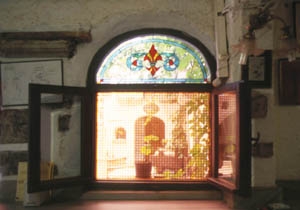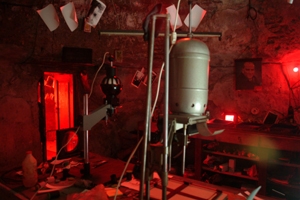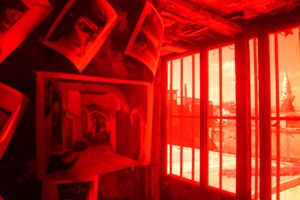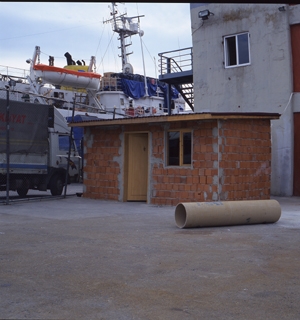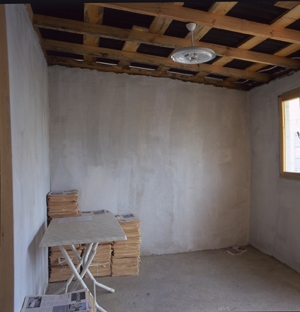Feature: Reviews
The 8th International Istanbul Biennial
As a city that straddles the East and the West both geographically and culturally, Istanbul is an important zone of passage from one drastically differing region to the next. To Europeans, it’s a point of entry into the Orient, and for Middle Easterners and Africans, it’s a portal into the Western world.
It’s no wonder, then, that the city’s strategic location has made it not only a point of convergence for varying cultural and regional influences, but also contested territory for differing populations with contrasting political agendas and religious beliefs. These contrasts are visible in every corner the city, and the conflicts that ensue are acted out regularly, sometimes in a violent fashion.
Last November, within days of the closing of the 8th International Istanbul Biennial, the city was hit by a series of deadly terrorist attacks. Bombs were first set off first at Jewish places of worship, then, a few days later, they blew apart a British bank and the British consulate, all located in populous financial and retail centers. These vicious stunts, set off by Islamist terrorists, were a symbolic protest against the compromising political situation that Turkey has found itself in as the global arena becomes polarized among political, religious and socioeconomic divisions.
It’s not a surprise that Turkey is constantly occupying a difficult “in between” zone within these divisions, since life in this country is compounded from an unlikely set of contrasts indeed. While predominantly a Moslem country, Turkey is also an important ally to U.S. and Israel. Its alliance with the U.S., however, didn’t prevent it from opposing the recent war on Iraq for fear that it would inflame separatist agendas among the Kurdish population living within its borders. Turkey can be described as a fanatically secular state, staunchly adhering to the need to keep its educational system and government free of religious doctrine, yet it has an increasing fundamentalist minority that is attempting to gain political power. The country’s Prime Minister, a conservative Moslem, is nonetheless pro-business, pro-capitalist and pro-Western, and has been vying to get the country into the EU since he took office. Economic instability is perhaps the biggest hardship for the Turkish population, who find themselves forever in limbo, trying to attain a modicum of financial stability in the face of skyrocketing inflation, a rising cost of living and stark class divide.
Yet the nation, with Istanbul, its cultural capital, setting the pace, still manages to barrel towards progress, almost seeming to become more emboldened by such paradoxes. It therefore offers loaded, yet fertile terrain upon which to foster an international dialogue on socioeconomic and sociopolitical concerns. It’s worth asking if such a dialogue, especially a broad reaching one, can be fostered around an art exhibition. It can if it’s about bolstering the economies of poorer nations through the impact of cultural tourism. Increasing tourism is, of course, an important aim of the Istanbul Foundation for Culture and Arts, which has been hosting the Istanbul Biennial since the late 1980s. There was even talk this past year of raising interest and finding potential funding for the development of a new museum of contemporary art in Istanbul. Among the arts community in Turkey, it is hoped that such an institution would be inclusive of a good number of contemporary Turkish artists, and would, ideally, help promote their names in the international art market.
In effect, the IFCC may have come close to achieving such aims with the 8th International Istanbul Biennial, achievements that, hopefully, will not be undone by the terrorist acts that ensued November. It was the consensus among many of the Istanbul Biennial’s attendees that this was the most successful iteration of the exhibition to date. Curated by Dan Cameron, chief curator of the New Museum in New York, this year’s exhibition utilized its context to maximum effect. The exhibition venues, four in all, with some additional sites for outdoor projects, made use of Istanbul’s most scenic areas and were staged within its most treasured cultural monuments. Splendid views of the Bosphorus and the historic villas and mosques lining its banks could be seen from the second floor balcony of the Antrepo, a former maritime warehouse that functioned as the cavernous main exhibition hall. The views offered a pleasant point of reprieve for those reaching saturation point from too much visual stimuli in the galleries. The Yerebatan Cistern, an ancient Roman cistern which served as a dark, dank and romantic setting for some of the more ornate video projections on view, augmented the mysterious nature of pieces such as Jennifer Steinkamp’s digitized, luminescent trees that swayed and shuddered in their hushed setting, their mirror images reflected upon the cistern’s shimmering pools of water. A sparer hanging of works was on display in the Tophane, a historic brick building formerly used to house the canons and artillery of the Ottomans. The minimal display complemented its elegant setting, where visitors had to navigate outdoor courtyards to pass from one domed gallery interior into the next. The Hagia Sophia, the magnificent Byzantine church built by emperor Justinian in the sixth century A.D., was a new venue choice for contemporary works this year. Unfortunately, this site may not have been the best choice, as the splendor of its architecture severely outshone and eclipsed the contemporary projects displayed within.
The appointment of New York-based Cameron as curator proved to be a diplomatically apt choice as well, especially in a post September-11th and post-Iraq war climate. Cameron’s selection of theme, that of “poetic justice,” may have reaffirmed—to the international arts community at least—that some Americans actually do wish to partake in an international dialogue about the impact of their foreign policy. In his curatorial essay, Cameron described “poetic justice” as a theme that is emblematic of a complicated world in which a sense of justice is forever shifting dependent upon position and rank. When differing populations are fighting over the same land, the same resources and the same rights, but political and military might determines who exactly has claim over that land, those resources and those rights, we are left with the question: “for whom, exactly, is there justice in this world”? What is deemed just or righteous for one population may have a devastating impact upon another. In answer, Cameron seems to have handed the exhibition platform over to the panoply of international voices, letting them all present their own views.
Approximately forty countries were represented among the over eighty artists in the Biennial this past year. A display of photographs and text by Palestinian artist Emily Jacir addressed the Palestinian diaspora by asking her people what they missed most about their homes in the occupied territories, and asking them to give her instructions to carry out in her travels in and out of the Middle East. The requests ranged from wishes to plant pomegranate seeds on Palestinian soil, to musings about playing soccer with kids on city streets. In another exhibition hall, Israeli artist Efrat Shvily presented a poignant video installation that showed Israelis singing familiar and hopeful songs about the future. The singing was representative of a ritual enacted by the Israelis in order to overcome the traumatic impact of Palestinian terrorism. Videos of a documentary nature were presented by Turkish artist Esra Esren, who explored xenophobia towards Middle Eastern immigrants in Northern Europe, and contrasted this with footage of African immigrants in Turkey expressing their grievances about the racial inequality they encountered their new home. Fikret Atay’s simple and straightforward video showed two Kurdish boys singing traditional songs in front of an ATM teller that they clearly had no access to, and was emblematic of class disparity, while representing yet another disenfranchised population.
Other projects positioned codified forms of competition such as sports and professional boxing as metaphors for heated confrontations between opposing factions. American artist Stephen Dean’s videos surveyed crowds of soccer fans going ballistic at soccer matches. The tremendous noise and energy issuing from the crowds offered an arresting view of how vehement people’s alliances can be to their teams of choice. Flags in the varying colors of these soccer teams were draped around the video projection, emphasizing the fact that the success of these teams is often equated with national pride, even though individual team members may be traded like goods in a transnational economy. Surasi Kusolwong’s Thai Box Match, performed in a ceremonial manner at the show’s opening reception, also married cultural or national identity with distinct modes of competition, but purposefully blurred their origins to address the impact of globalism. Kusolwong took two Turkish wrestlers and had them trained in the traditional sport of Thai kickboxing. This dispersal of a traditional sport born of a certain locale addressed the problematic notion of “authenticity.” When cultural forms distinct to certain populations—whether they are dance, music or even sports, like Thai kickboxing—are exported and popularized on a global scale, how does this affect the originator’s relationship to these cultural forms? When the most basic locators of identity, from food, to clothing, to ritual, are dispersed internationally, what type of cultural dislocation ensues? The boxing match lasted five grueling rounds, and was as entertaining as it was suspenseful. Kusolwong further tweaked the rules of the game by democratizing the sport. He had the audience in attendance vote on who they thought the winner should be, offering a symbolic, yet idealized vision of conflict resolution in the global arena: one nation or population abiding by the rules of another in order to participate in a global exchange, and an international community of representatives judging the success and outcome of that exchange.
Perhaps it’s not too much of a conceptual leap to think of international art biennials as a similar type of summit, one in which a global dialogue on contemporary art production is fostered. It becomes relevant to include the voices of underprivileged populations in such a dialogue when the unifying themes address social concerns. With discussion topics such as “New Countries, New Identity, New Art;” “Justice and the Creative Act” and “Radical Poetics,” the panels accompanying the Biennial further brought to light the sociopolitical concerns underpinning much of the work on view. There are those in the art world who think that art engaging in social and political commentary is either too dull or too moralistic to be compelling. Of course, depending on current events, such work is more germane to certain locales than others. Cameron’s theme seemed perfectly situated in city such as Istanbul, a site where different social realities and political agendas often collide with one another. His curatorial effort was also successful in building the case that charged messages are subsumed more easily when a poetic flourish is thrown in. Humor and invention acts in a similar way to help bitter taste of political critique go down. The consensus in the panel discussions seemed to be that it was too much to expect an artist to be an agent of social change, or to speak on behalf of a particular community. Rather, the hope is that art can convey social realities by offering a culturally and geographically diverse array of perspectives, thereby preventing oversimplified reads of complicated issues or clear cut definitions of justice.
Photos by Muammer Yanmaz except as otherwise credited.

